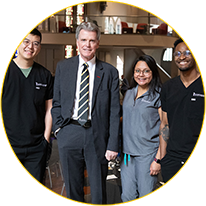Mary Ann Jabra-Rizk, PhD, MPower professor and professor of Oncology and Diagnostic Sciences at the University of Maryland School of Dentistry (UMSOD), has made significant strides in understanding Candida auris — or C. auris — a multi-drug resistant human fungal pathogen that has emerged as a global health challenge.

Mary Ann Jabra-Rizk, PhD
Recently, Dr. Jabra-Rizk published two groundbreaking papers: “Functional redundancy in Candida auris cell surface adhesins crucial for cell-cell interaction and aggregation,” in the October 2024 issue of the journal Nature Communications; and “SARS-CoV-2 infection of salivary glands compromises the production of a secreted antifungal peptide with potential implications for development of oral candidiasis,” which was published in December 2024 in the journal PLoS Pathogens.
Both studies highlight how disruptions in the host’s immune defenses contribute to Candida's persistence and increased infection risk.
What initially sparked your interest in studying fungal pathogens like C. auris?
I knew early on that I wanted to pursue a career in microbiology, with a particular focus on fungal pathogens. My early research centered on Candida albicans (C. albicans) and fungal pathogenesis remained my main area of study throughout my career. In 2018, my research shifted to C. auris – a newly identified species that emerged independently across five continents.
Since its discovery in Japan in 2009, C. auris has caused an exponential emergence in health care-associated systemic infections and outbreaks worldwide. With increasing emergence of resistance to available antifungal treatments, there is an urgent need to identify new drug targets and develop novel therapies to curtail the spread of this deadly fungal pathogen.
How does C. auris compare to other fungal pathogens in terms of its ability to spread?
C. auris is related to other Candida species but exhibits distinct characteristics, making it a new species. Dubbed a “superbug”, auris exhibits several concerning features, including its ability to resist common disinfectants, colonize skin and surfaces persistently, and spread rapidly in health care settings, causing outbreaks.
Most concerning is its ability to quickly develop resistance to multiple antifungal agents, with mortality rates approaching 68 percent. In 2023, the World Health Organization ranked C. auris as a critical priority pathogen, and the Centers for Disease Control and Prevention has classified it as an urgent public health threat.
Can you briefly describe the findings in your two recent papers?
In the C. auris project, we explored the transcriptional changes enabling C. auris to adhere to intravascular catheters, key predictors of hospital infections. Using a mouse model of catheter infection and gene editing, we identified novel adhesins with functional redundancy that promote cell-cell interaction and catheter adherence. These findings highlight C. auris' flexibility and rapid environmental adaptation, which may contribute to its persistence and virulence in health care settings.
In the COVID-19 project, we investigated how SARS-CoV-2 affects the secretion of histatin-5, a salivary antimicrobial peptide important for preventing Candida colonization. Using tissue from COVID-19 autopsies, we showed that SARS-CoV-2 replicates in salivary glands, disrupting histatin-5 production and promoting C. albicans growth.
What are some of the next steps in your research on C. auris?
A great deal is still unknown about how C. auris evolves, causes disease, and, importantly, develops antifungal resistance, which is the focus of our current research. In our pending R01 National Institutes of Health grant proposal, we plan to use our mouse catheter infection model to evaluate how C. auris adapts to antifungal drugs during treatment, potentially conferring tolerance or resistance. Identifying drug-responsive gene expression and mutations could lead to the discovery of novel drug targets for future therapeutic development.
To learn more about these findings and other microbiological research currently underway at UMSOD, visit dental.umaryland.edu/about/news.



